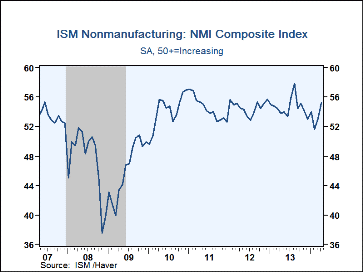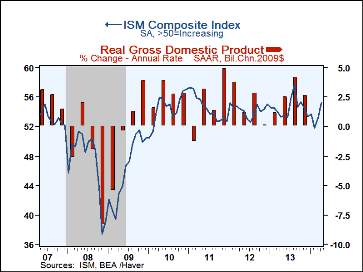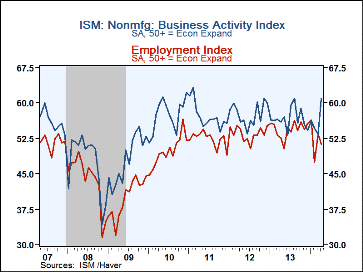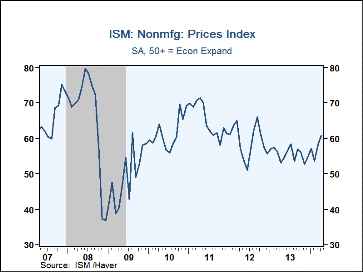 Global| May 05 2014
Global| May 05 2014U.S. ISM Nonmanufacturing Index Improves Again
by:Tom Moeller
|in:Economy in Brief
Summary
The Composite Index for the service and construction sectors from the Institute for Supply Management (ISM) rose to 55.2 in April, the second consecutive monthly gain. The latest figure beat expectations for 54.0 in the Action [...]
The Composite Index for the service and construction sectors from the Institute for Supply Management (ISM) rose to 55.2 in April, the second consecutive monthly gain. The latest figure beat expectations for 54.0 in the Action Economics Forecast Survey. During the last ten years, there has been a 75% correlation between the level of the nonmanufacturing composite index and the q/q change in real GDP for the service and the construction sectors.
Haver Analytics calculates an index using the ISM nonmanufacturing series and the ISM manufacturing sector index released Thursday. The April figure also increased to 55.2 from a February low of 51.8. During the last ten years, there has been a 76% correlation between this composite index and the quarterly change in real GDP.
Leading the nonmanufacturing index higher last month was a jump in the business activity series to 60.9, its highest level since August. Rising sharply as well was the new orders figure to 58.2, also its highest point since August. Countering these gains was a moderate drop in nonmanufacturing payrolls to 51.3. During the last ten years, there has been an 89% correlation between the employment index and the m/m change in private service sector plus construction payrolls. The supplier delivery index also fell to 50.5, indicating the quickest delivery speeds in six months.
The prices paid index jumped to 60.8, its highest level since October 2012. Thirty one percent of respondents indicated higher prices last month while four percent reported them lower. During the last ten years, there has been a 78% correlation between the price index and the q/q change in the GDP services chain price index.
Beginning with the January 2008 Nonmanufacturing Report On Business, the composite index is calculated as an indication of overall economic conditions for the nonmanufacturing sector. It is a composite index based on the diffusion indices of four of the indicators (business activity, new orders, employment and supplier deliveries), each with equal weights. Readings above 50 indicate expansion in activity.
The ISM data are available in Haver's USECON database. The expectations figure from Action Economics is in the AS1REPNA database.
| ISM Nonmanufacturing Survey (SA) | Apr | Mar | Feb | Apr'13 | 2013 | 2012 | 2011 |
|---|---|---|---|---|---|---|---|
| Composite Diffusion Index | 55.2 | 53.1 | 51.6 | 53.8 | 54.7 | 54.6 | 54.4 |
| Business Activity | 60.9 | 53.4 | 54.6 | 55.9 | 56.7 | 57.7 | 57.2 |
| New Orders | 58.2 | 53.4 | 51.3 | 55.7 | 55.9 | 56.6 | 56.3 |
| Employment | 51.3 | 53.6 | 47.5 | 52.6 | 54.4 | 53.5 | 52.4 |
| Supplier Deliveries (NSA) | 50.5 | 52.0 | 53.0 | 51.0 | 51.7 | 50.6 | 51.9 |
| Prices Index | 60.8 | 58.3 | 53.7 | 53.0 | 55.6 | 59.3 | 65.1 |
Tom Moeller
AuthorMore in Author Profile »Prior to joining Haver Analytics in 2000, Mr. Moeller worked as the Economist at Chancellor Capital Management from 1985 to 1999. There, he developed comprehensive economic forecasts and interpreted economic data for equity and fixed income portfolio managers. Also at Chancellor, Mr. Moeller worked as an equity analyst and was responsible for researching and rating companies in the economically sensitive automobile and housing industries for investment in Chancellor’s equity portfolio. Prior to joining Chancellor, Mr. Moeller was an Economist at Citibank from 1979 to 1984. He also analyzed pricing behavior in the metals industry for the Council on Wage and Price Stability in Washington, D.C. In 1999, Mr. Moeller received the award for most accurate forecast from the Forecasters' Club of New York. From 1990 to 1992 he was President of the New York Association for Business Economists. Mr. Moeller earned an M.B.A. in Finance from Fordham University, where he graduated in 1987. He holds a Bachelor of Arts in Economics from George Washington University.










